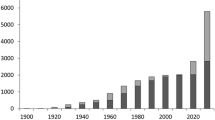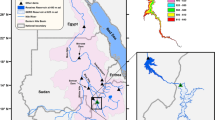Abstract
Hydroelectric dams in tropical forest areas emit greenhouse gases, as illustrated by the Curuá-Una Dam in the Amazonian portion of Brazil. Emissions include carbon dioxide from decay of the above-water portions of trees that are left standing in the reservoir and methane from soft vegetation that decays under anaerobic conditions on the bottom of the reservoir, especially macrophytes (water weeds) and vegetation that grows in the drawdown zone and is flooded when the reservoir water level rises. Some methane is released from the reservoir surface through bubbling and diffusion, but larger amounts are released from water passing through the turbines and spillway. Methane concentration in the water increases with depth, and the turbines and spillway draw water from sufficient depth to have substantial methane content. In 1990 (13 years after filling), the Curuá-Una Dam emitted 3.6 times more greenhouse gases than would have been emitted by generating the same amount of electricity from oil.
Similar content being viewed by others
References
Barbosa, R.I. and Fearnside, P.M.: 1996, ‘,Pasture burning in Amazonia: Dynamics of residual biomass and the storage and release of aboveground carbon’, Journal of Geophysical Research (Atmospheres) 101(D20), 25847–25857.
Brazil, ANEEL: 2001, Mapa. http://www.aneel.gov.br/defaultmapa.html, Brasília, DF, Brazil, Agência Nacional de Energia Elétrica (ANEEL).
Brazil, CEPEL/ELETROBRÁS: 1983, Relatório Técnico final No. 963/83. Estudo comparativo de manutenção nas usinas de Curuá-Una e Moxot'o, Rio de Janeiro, RJ, Brazil, Centro de Pesquisas de Energia El'etrica-CEPEL, Centrais El'etricas Brasileiras (ELETROBR'AS), pp. 48
Brazil, ELETRONORTE: 1989, Usina Hidrel'etrica Tucuruí: Mem'oria T'ecnica, Brasilia, DF, Brazil, Diretoria T'ecnica (DT), Departamento de Projetos (TPR), Projeto Mem'oria, Centrais El'etricas do Norte do Brasil (ELETRONORTE), pp. 681.
Brazil, ELETRONORTE: nd [C. 1987], UHE Samuel, Brasília, DF, Brazil Centrais El'etricas do Norte do Brasil S.A. (ELETRONORTE), pp. 22.
Brazil, IBGE and IBDF: 1988, Mapa de Vegetação do Brasil. Map scale: 1:5 000 000, Instituto Brasileiro de Geografia e Estatística (IBGE) & Instituto Brasileiro de Desenvolvimento Florestal (IBDF), Brasília, DF, Brazil, Instituto Brasileiro do Meio Ambiente e dos Recursos Naturais Renov'aveis (IBAMA).
Brezny, O., Mehta, I. and Sharma, R.K.: 1973, ‘,Studies on evapotranspiration of some aquatic weeds’, Weed Science 21(3), 197–204.
CELPA: nd [C. 1975], Usina Hidroelétrica de Curuá-Una, Bel'em, Pará, Brazil Centrais El'etricas do Pará S.A. (CELPA), pp. 8.
de Lima, I.B.T. 2002. Emissão de metano em reservat'orios hidrel'etricos amazônicos atrav'es de leis de pot'encia. Ph.D. thesis in nuclear energy, Piracicaba, São Paulo, SP, Brazil, Centro de Energia Nuclear na Agricultura (CENA), Universidade de São Paulo, pp. 108.
Duchemin, E., Lucotte, M., Canuel, R., Queiroz, A.G, Almeida, D.C, Pereira, H.C. and Dezincourt, J.: 2000, ‘,Comparison of greenhouse gas emissions from an old tropical reservoir with those of other reservoirs worldwide’, Verhandlungen International Vereinigung für Limnologie 27, 1391– 1395.
Duchemin, 'E., Lucotte, M., St-Louis, V. and Canuel, R.: 2002, ‘,Hydroelectric reservoirs as an anthropogenic source of greenhouse gases’, World Resource Review 14, 334–353.
Fearnside, P.M.: 1994, ‘,Biomassa das florestas amazônicas brasileiras’, in Anais do Semin'ario Emissão X Seqüestro de CO 2. Companhia Vale do Rio Doce (CVRD), Rio de Janeiro, RJ, Brazil. pp. 95–124.
Fearnside, P.M.: 1995, ‘,Hydroelectric dams in the Brazilian Amazon as sources of ‘,greenhouse’ gases’, Environmental Conservation 22, 7–19.
Fearnside, P.M.: 1996, ‘,Amazonia and global warming: Annual balance of greenhouse gas emissions from land-use change in Brazil's Amazon region’, in J. Levine (ed.), Biomass Burning and Global Change. Volume 2: Biomass Burning in South America, Southeast Asia and Temperate and Boreal Ecosystems and the Oil Fires of Kuwait, Cambridge, Massachusetts, U.S.A., MIT Press, pp. 606–617.
Fearnside, P.M.: 1997a, ‘,Greenhouse gases from deforestation in Brazilian Amazonia: Net committed emissions’, Climatic Change 35, 321–360.
Fearnside, P.M.: 1997b, ‘,Greenhouse gas emissions from Amazonian hydroelectric reservoirs: The example of Brazil's Tucuruí Dam as compared to fossil fuel alternatives’, Environmental Conservation 24, 64–75.
Fearnside, P.M.: 2002a, ‘,Greenhouse gas emissions from a hydroelectric reservoir (Brazil's Tucuruí Dam) and the energy policy implications’, Water, Air and Soil Pollution 133, 69–96.
Fearnside, P.M.: 2002b, ‘,Time preference in global warming calculations: A proposal for a unified index’, Ecological Economics 41, 21–31.
Fearnside, P.M.: 2002c, ‘,Why a 100-year time horizon should be used for global warming mitigation calculations’, Mitigation and Adaptation Strategies for Global Change 7, 19–30.
Fearnside, P.M.: 2004, ‘,Greenhouse gas emissions from hydroelectric dams: Controversies provide a springboard for rethinking a supposedly “clean” energy source’, “Climatic Change 66, 1–8.
Fearnside, P.M.: in press, ‘,Brazil's Samuel Dam: Lessons for hydroelectric development policy and the environment in Amazonia’, Environmental Management.
Fearnside, P.M., Lashof, D.A. and Moura-Costa, P.: 2000, ‘,Accounting for time in mitigating global warming through land-use change and forestry’, Mitigation and Adaptation Strategies for Global Change 5, 239–270.
Fearnside, P.M. and Laurance, W.F.: 2004, ‘,Tropical deforestation and greenhouse gas emissions’, Ecological Applications 14, 982–986.
Fearnside, P.M., Leal Filho, N. and Fernandes, F.M.: 1993, ‘,Rainforest burning and the global carbon budget: Biomass, combustion efficiency and charcoal formation in the Brazilian Amazon’, Journal of Geophysical Research (Atmospheres) 98(D9), 16733–16743.
Galy-Lacaux, C., Delmas, R., Jambert, C., Dumestre, J.-F., Labroue, L., Richard, S. and Gosse, P.: 1997, ‘,Gaseous emissions and oxygen consumption in hydroelectric dams: A case study in French Guyana’, Global Biogeochemical Cycles 11, 471–483.
Galy-Lacaux, C., Delmas, R., Kouadio, J., Richard, S. and Gosse, P.: 1999, ‘,Long-term greenhouse gas emissions from hydroelectric reservoirs in tropical forest regions’, Global Biogeochemical Cycles 13, 503–517.
Gunkel, G., Lange, U., Walde, D. and Rosa, J.W.C.: 2003, ‘,The environmental and operational impacts of Curuá-Una, a reservoir in the Amazon region of Pará, Brazil’, Lakes & Reservoirs: Research and Management 8(3–4), 201–216.
International Rivers Network: 2002, Flooding the Land, Warming the Earth: Greenhouse Gas Emissions from Dams, Berkeley, California, U.S.A., International Rivers Network, pp. 18.
IPCC: 1997, Revised 1996 Intergovernmental Panel on Climate Change Guidelines for National Greenhouse Gas Inventories, Bracknell, UK, Intergovernmental Panel on Climate Change (IPCC), 3 vols.
Junk, W.J.: 1982, ‘,Zur entwicklung aquatischer makrophyten in Curuá-Una, dem ersten stausee in Zentralamazonien’, Arch. Hydrobiol. 95, 169–180.
Junk, W.J. and de Mello, J.A.S.: 1987, ‘,Impactos ecol'ogicos das represas hidrel'etricas na bacia amazônica brasileira’, in G. Kohlhepp and A. Schrader (eds.), Homem e Natureza na Amazônia. Tübinger Geographische Studien 95 (Tübinger Beiträge zur Geographischen Lateinamerika-Forschung 3). Tübingen, Germany, Geographisches Institut, Universität Tübingen, pp. 367– 385.
Junk, W.J. and Piedade, M.T.F.: 1997, ‘,Plant life in the floodplain with special reference to herbaceous plants’, in W.J. Junk (ed.) The Central Amazon Floodplain – Ecology of a Pulsing System. Heidelberg, Germany, Springer-Verlag, pp. 147–185.
Junk, W.J., Robertson, B.A., Darwich, A.J. and Vieira, I.: 1981, ‘,Investigações limnol'ogicas e ictiol'ogicas em Curuá-Una, a primeira represa hidrel'etrica na Amazônia Central’, Acta Amazonica 11, 689–716.
Martius, C., Fearnside, P.M., Bandeira, A.G. and Wassmann, R.: 1996, ‘,Deforestation and methane release from termites in Amazonia’, Chemosphere 33(3), 517–536.
Nogueira, E.: 2004, Biomassa de 'arvores na Amazônia Central: Densidade de Madeira, Volume do Fuste e Ocorrência de Oco. Masters thesis in tropical forest science, Manaus, Amazonas, Brazil, Instituto Nacional de Pesquisas da Amazônia (INPA) and Universidade Federal do Amazonas (UFAM), pp. 96.
Nogueira, E.M., Nelson, B.W. and Fearnside, P.M.: 2004, ‘,Wood density in dense forest in central Amazonia, Brazil’, Forest Ecology and Management (forthcoming).
Paiva, M.P.: 1977, The Environmental Impact of Man-Made Lakes in the Amazonian Region of Brazil. Rio de Janeiro, RJ, Brazil, Centrais El'etricas Brasileiras S.A. (ELETROBR'AS) Diretoria de Coordenação, pp. 69.
Polunin, N.V.C.: 1984, ‘,The decomposition of emergent macrophytes in fresh water’, Advances in Ecological Research 14, 115–168.
Ramaswamy, V. and 40 others: 2001, ‘,Radiative forcing of climate change’, in J.T. Houghton, Y. Ding, D.G. Griggs, M. Noguer, R.J. Van der Linden and D. Xiausu (eds.), Climate Change 2001: The Scientific Basis. Cambridge, UK, Cambridge University Press, pp. 944.
Robertson, B.A.: 1980, ‘,Composição, Abundância e Distribuição de Cladocera (Crustacea) na Região de 'Agua Livre da Represa de Curuá-Una, Pará’, Master's thesis in freshwater biology and inland fisheries, Fundação Universidade do Amazonas (FUA) and Instituto Nacional de Pesquisas da Amazônia (INPA), Manaus, Amazonas, Brazil, INPA, pp. 105.
Rosa, L.P., dos Santos, M.A., Matvienko, B., dos Santos, E.O. and Sikar, E.: 2004, ‘,Greenhouse gases emissions by hydroelectric reservoirs in tropical regions’, Climatic Change 66, 9–21.
Rosa, L.P., dos Santos, M.A., Tundisi, J.G. and Sikar, B.M.: 1997, ‘,Measurements of greenhouse gas emissions in Samuel, Tucuruí and Balbina Dams’, in L.P. Rosa and M.A. dos Santos (eds.), Hydropower Plants and Greenhouse Gas Emissions, Rio de Janeiro, RJ, Brazil, Coordenação dos Programas de P'os-Graduação em Engenharia da Universidade Federal do Rio de Janeiro (COPPE/UFRJ), pp. 41–55.
Rosa, L.P., Sikar, B.M., dos Santos, M.A. and Sikar, E.M.: 2002, Emissões de di'oxido de carbono e de metano pelos reservat'orios hidrel'etricos brasileiros. Relat'orio de Referência, Primeiro Invent'ario Brasileiro de Emissões Antr'opicas de Gases de Efeito Estufa, Brasília, DF, Brazil, Minist'erio da Ciência e Tecnologia, pp. 119 (http://www.mct.gov.br/clima/comunic_old/pdf/metano_p.pdf)
Schimel, D. and 75 others: 1996, ‘,Radiative forcing of climate change’, in J.T. Houghton, L.G. Meira Filho, B.A. Callander, N. Harris, A. Kattenberg and K. Maskell (eds.), Climate Change 1995: The Science of Climate Change, Cambridge, UK, Cambridge University Press, pp. 65–131.
St-Louis, V., Duchemin, 'E., Kelly, C.A., Rudd, J.W.M. and Rosenberg, D.M.: 2002, ‘,Reservoir surfaces as sources of greenhouse gases: A global estimate’, BioScience 50, 766–775.
Timmer, C.E. and Weldon, L.W.: 1967, ‘,Evapotranspiration and pollution of waterhyacinth’, Hyacinth Control Journal 6, 34–37.
van de Vate, J.F.: 1996, ‘,Hydropower: Potential sources of greenhouse gases’, in Assessment of Greenhouse Gas Emissions from the Full Energy Chain for Hydropower, Nuclear Power and Other Energy Sources. Papers Presented at an IAEA Advisory Group Meeting Jointly Organized by Hydro-Qu'ebec and the International Atomic Energy Agency, Hydro-Qu'ebec Headquarters, Montr'eal (Canada) 12–14 March 1996, Geneva, Switzerland. International Atomic Energy Agency (IAEA), (II-AG-832.4), Irregular pagination.
Vieira, I.: 1982, Aspectos Sinecol'ogicos da Ictiofauna de Curuá-'Una, Represa Hidroel'etrica da Amazônia Brasileira. “Livre docencia” thesis in biology, Juiz de Fora, Minas Gerais, Brazil, Universidade Federal de Juiz de Fora, pp. 107.
Walker, I., Miyai, R. and de Melo, M.D.A.: 1999, ‘,Observations on aquatic macrophyte dynamics in the reservoir of the Balbina hydroelectric powerplant, Amazonas state, Brazil’, Acta Amazonica 29, 243–265.
Author information
Authors and Affiliations
Corresponding author
Rights and permissions
About this article
Cite this article
Fearnside, P.M. Do Hydroelectric Dams Mitigate Global Warming? The Case of Brazil's CuruÁ-una Dam. Mitig Adapt Strat Glob Change 10, 675–691 (2005). https://doi.org/10.1007/s11027-005-7303-7
Received:
Accepted:
Issue Date:
DOI: https://doi.org/10.1007/s11027-005-7303-7




